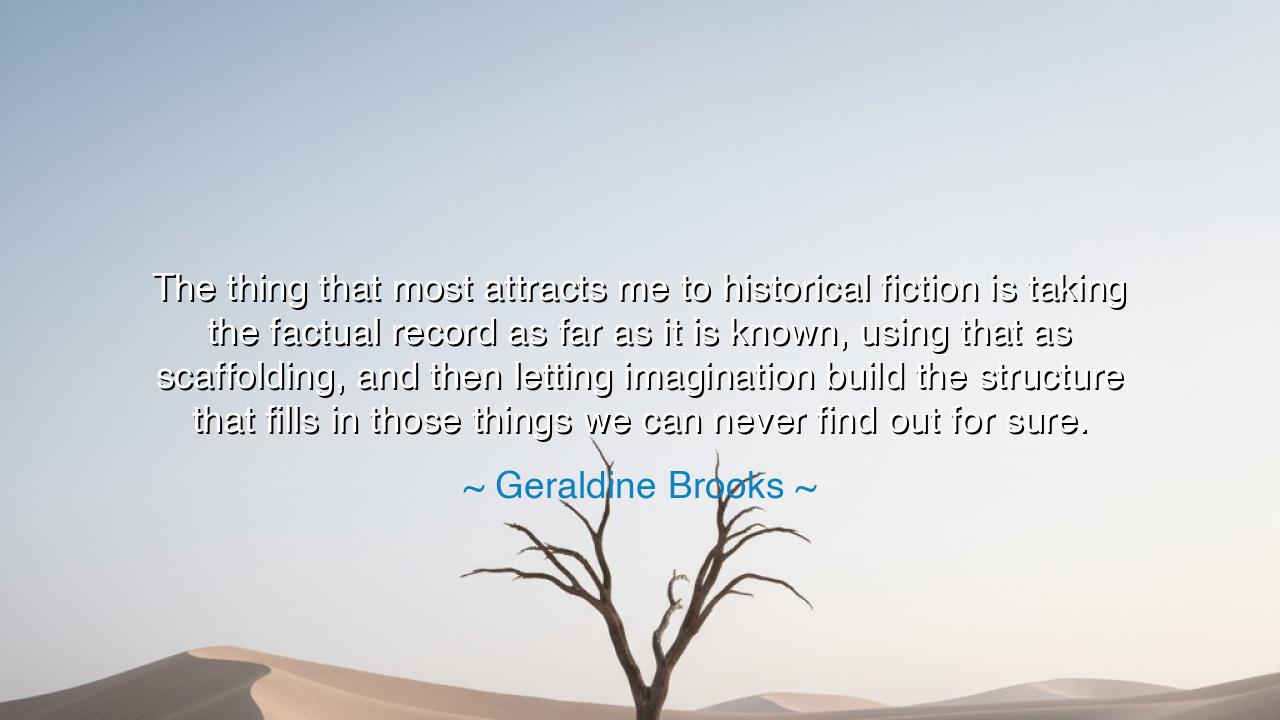
The thing that most attracts me to historical fiction is taking
The thing that most attracts me to historical fiction is taking the factual record as far as it is known, using that as scaffolding, and then letting imagination build the structure that fills in those things we can never find out for sure.






When Geraldine Brooks declared, “The thing that most attracts me to historical fiction is taking the factual record as far as it is known, using that as scaffolding, and then letting imagination build the structure that fills in those things we can never find out for sure,” she was speaking as one who walks between two sacred worlds—the world of truth and the world of imagination. Her words reveal a profound reverence for both history and creativity, showing that art does not oppose truth, but rather completes it. For the historical record, though precious, is full of silences—moments unrecorded, hearts unspoken, dreams forgotten. Into those silences steps the imagination, the eternal builder, breathing life once more into the bones of time.
In her wisdom, Brooks reminds us that the past is not merely a collection of dates and names—it is a living mystery, half-known and half-lost. The historian may chart the facts, but only the storyteller can restore their heartbeat. The scaffolding of fact, as she calls it, is the skeleton of reality, strong and true; but it is imagination that fashions the flesh and soul of history, allowing us to feel what the record alone cannot convey. The greatest truths of humanity—love, fear, hope, courage—are not found in dusty archives but in the unspoken spaces between them. There, imagination enters as both artist and priest, translating silence into meaning.
This philosophy has its roots deep in the ancient art of storytelling, where the line between truth and myth was not a wall but a bridge. The poets of Greece sang of Troy, and though their facts were uncertain, their visions carried truths more enduring than any chronicle. The historian might debate whether Helen ever lived, but the storyteller reveals the cost of beauty, the fire of desire, the tragedy of pride. In the same way, Brooks stands in this ancient lineage—honoring the truth where it can be known, yet refusing to let what is lost remain lifeless. For the purpose of historical fiction is not to deceive, but to resurrect—to give voice to the forgotten and restore humanity to history.
Consider the tale of Hildegard of Bingen, the medieval mystic and composer. The records tell us of her works, her convent, her visions; but what did she feel when she first heard the divine melody that changed her life? What private doubts haunted her faith? The historian cannot tell us—but the imagination can. It is the imagination that paints the color upon the gray stones of time, that allows us to step inside the hearts of the dead and see through their eyes. Thus, as Brooks teaches, imagination does not destroy truth—it completes it. It makes the past breathe again, not as relic, but as revelation.
In her own life as a journalist turned novelist, Brooks learned to honor both the discipline of fact and the freedom of story. She understood that the two are not enemies but allies. Facts anchor us, keeping our creations from drifting into falsehood, but imagination gives those facts wings, allowing them to soar into meaning. Without imagination, history becomes sterile—a museum of artifacts without soul. Without fact, imagination becomes delusion—a mirage without ground. The harmony of the two produces wisdom, the union of what was and what might have been.
And what lesson, then, shall we take from her words? It is this: do not fear the unknown, but meet it with imagination. Whether we seek to understand the past or to create our own future, there will always be mysteries beyond our reach. Facts will guide us only so far; beyond them lies the realm of wonder, where insight is born. To imagine is not to abandon truth, but to enlarge it—to see not only with the eyes, but with the soul. In the stories we tell, in the lives we live, we too must build upon the scaffolding of what we know and dare to dream the rest.
Therefore, dear listener, let the wisdom of Geraldine Brooks echo in your own pursuit of meaning. When faced with the gaps in knowledge, do not despair—create. When history is silent, listen inwardly. When truth ends, let imagination continue its song. For between fact and faith, memory and dream, lies the space where all great art—and indeed, all great humanity—resides. To live well, like the storyteller, is to honor both what is known and what is unknowable, to build with both reason and wonder, until the story of life itself becomes whole once more.






AAdministratorAdministrator
Welcome, honored guests. Please leave a comment, we will respond soon